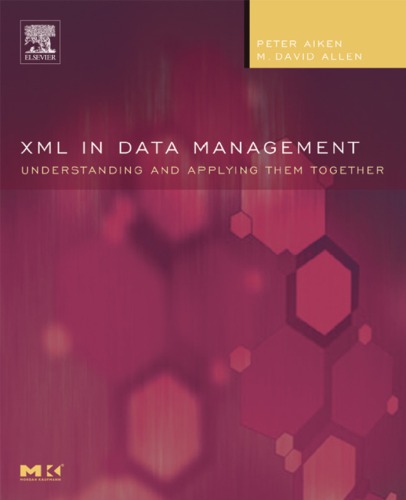

Most ebook files are in PDF format, so you can easily read them using various software such as Foxit Reader or directly on the Google Chrome browser.
Some ebook files are released by publishers in other formats such as .awz, .mobi, .epub, .fb2, etc. You may need to install specific software to read these formats on mobile/PC, such as Calibre.
Please read the tutorial at this link: https://ebookbell.com/faq
We offer FREE conversion to the popular formats you request; however, this may take some time. Therefore, right after payment, please email us, and we will try to provide the service as quickly as possible.
For some exceptional file formats or broken links (if any), please refrain from opening any disputes. Instead, email us first, and we will try to assist within a maximum of 6 hours.
EbookBell Team

4.0
56 reviews
ISBN 10: 0120455994
ISBN 13: 978-0120455997
Author: Peter Aiken, David Allen
XML in Data Management is for IT managers and technical staff involved in the creation, administration, or maintenance of a data management infrastructure that includes XML. For most IT staff, XML is either just a buzzword that is ignored or a silver bullet to be used in every nook and cranny of their organization. The truth is in between the two. This book provides the guidance necessary for data managers to make measured decisions about XML within their organizations. Readers will understand the uses of XML, its component architecture, its strategic implications, and how these apply to data management.
Chapter 1. XML and DM Basics
Introduction
The DM Challenge
Definitions
DM Overview
Investing in Metadata/Data Management
XML Hype: Management by Magazine
Two Examples of XML in Context
XML & DM Interaction Overview
What XML Is Not: XML Drawbacks and Limitations
Chapter Summary
References
Chapter 2. XML from the Builder's Perspective: Using XML to Support DM
Chapter Overview
XML Builder's Overview
XML Usage in Support of DM Builder's Perspective
Chapter Summary
References
Chapter 3. XML Component Architecture (as it relates to DM)
Introduction
XML Design Considerations
XML Component Architecture (Parts & Pieces)
Conclusion
Chapter 4. XML and Data Engineering
Introduction
Typical XML First Steps
Engineering XML-Based Data Structures as Part of an Organizational Data Architecture
XML, Security, and Data Engineering
Data Mapping Case Study
Chapter Summary
References
Chapter 5. Making and Using XML: The Data Managers' Perspective
Introduction
Input
Processing XML
Outputting XML
Data Management Maturity Measurement (DM3)
Chapter Summary
References
Chapter 6. XML Frameworks
Introduction
Framework Advantages
RosettaNet
ebXML
Microsoft Offerings: BizTalk and .Net
Industry-Specific Initiatives
Common Themes and Services
Conclusion
Chapter 7. XML-Based Portal Technologies and Data-Management Strategies
Chapter Overview
Portal Hype
The Need Legacy Code Maintenance Burden
Aiding Implementation of Information-Engineering Principles with XML-Based Portal Architectures
Clarifying Excitement Surrounding XML-Based Portals (XBPs)
XML-Based Portal Technology
XML-Based Architectural Enhancements
Enhanced Integration Opportunities
Extending Data-Management Technologies/ Data-Management Product Examples
Newly Important and Novel Data-Preparation Opportunities
Greater Business and System-Reengineering Opportunities: Reduction of Maintenance Burden Strategies
Conclusion
References
Chapter 8. Focusing XML and DM on Enterprise Application Integration (EAI)
Introduction
What Is It About XML That Supports EAI?
EAI Basics
EAI Past and Current Focus
EAI Challenges
Conclusion
References
Chapter 9. XML, DM, and Reengineering
Introduction
Two Types of Reengineering
How XML + DM Facilitates Reengineering Efforts
Chapter Summary
References
Chapter 10. Networks of Networks, Metadata, and the Future
Introduction
A Different Understanding of Data and Its Metadata
The Internet Metaphor
Internal Organizational Structure
Industry Structure
Inter-Industry Structure
Bringing It Together: Observations About the Internet Metaphor
Conclusion
Chapter 11. Expanded Data-Management Scope
Introduction
Thought Versus Action
Understanding Important Data Structures as XML
Resolving Differing Priorities
Producing Innovative XML-Based It Savings
Increasing Scope and Volume of Data Management
Greater Payoff for Preparation
Understanding the Growth Patterns in Your Operational Environment
Chapter Summary
References
Glossary of Acronyms
Index
what is xml in dbms
xml file requirements
xml database management systems
xml data storage
xml data management
Tags: Peter Aiken, David Allen, Data Management, Them Together